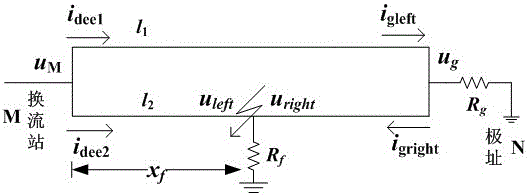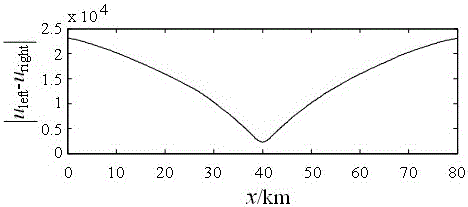A Time-Domain Fault Location Method for HVDC Grounding Electrode Lines Based on Bergeron Model
A technology of high-voltage direct current and distance measurement method, which is applied in the direction of the fault location, etc., which can solve the problems of high probability of fault, low voltage of the ground electrode line, and inability to accurately measure the distance of the fault of the ground electrode line, so as to achieve high reliability of distance measurement and measurement High precision, easy to achieve effect
- Summary
- Abstract
- Description
- Claims
- Application Information
AI Technical Summary
Problems solved by technology
Method used
Image
Examples
Embodiment 1
[0030] Example 1: 800kV DC grounding line such as figure 1 shown. The line parameters are as follows: the total length of the line is 80km, the DC impedance is 0.023165Ω / km, and the pole resistance is 0.2Ω. The data sampling rate is 1MHz. Ground electrode line l 2 A ground fault occurred 10km away from the measuring end, and the transition resistances were 0.2Ω, 2Ω, and 5Ω.
[0031] The steps of the time-domain fault location method for HVDC grounding pole lines based on the Bergeron model are as follows:
[0032] (1) Extract the voltage u at the measuring terminal of the ground electrode lead M (t) and fault line current i dee2 (t), the voltage value on the left side of the fault point is estimated based on the voltage distribution formula along the Bergeron line model :
[0033] (1)
[0034] In the formula, r, , v are resistivity, characteristic impedance, wave velocity respectively, u M (t) is the measured terminal voltage at time t, i dee2 (t) is the faul...
Embodiment 2
[0045] Example 2: 800kV DC grounding line such as figure 1 shown. The line parameters are as follows: the total length of the line is 80km, the DC impedance is 0.023165Ω / km, and the pole resistance is 0.2Ω. The data sampling rate is 1MHz. Ground electrode line l 2 A ground fault occurred 40km away from the measuring end, and the transition resistances were 0.2Ω, 2Ω, and 5Ω.
[0046] The steps of the time-domain fault location method for HVDC grounding pole lines based on the Bergeron model are as follows:
[0047] (1) Extract the voltage u at the measuring terminal of the ground electrode lead M (t) and fault line current i dee2 (t), the voltage value on the left side of the fault point is estimated based on the voltage distribution formula along the Bergeron line model :
[0048] (1)
[0049] In the formula, r, , v are resistivity, characteristic impedance, wave velocity respectively, u M (t) is the measured terminal voltage at time t, i dee2 (t) is the faul...
Embodiment 3
[0060] Example 3: 800kV DC grounding line such as figure 1 shown. The line parameters are as follows: the total length of the line is 80km, the DC impedance is 0.023165Ω / km, and the pole resistance is 0.2Ω. The data sampling rate is 1MHz. Ground electrode line l 2 A ground fault occurred 70km away from the measuring end, and the transition resistances were 0.2Ω, 2Ω, and 5Ω.
[0061] The steps of the time-domain fault location method for HVDC grounding pole lines based on the Bergeron model are as follows:
[0062] (1) Extract the voltage u at the measuring terminal of the ground electrode lead M (t) and fault line current i dee2 (t), the voltage value on the left side of the fault point is estimated based on the voltage distribution formula along the Bergeron line model :
[0063] (1)
[0064] In the formula, r, , v are resistivity, characteristic impedance, wave velocity respectively, u M (t) is the measured terminal voltage at time t, i dee2 (t) is the faul...
PUM
 Login to View More
Login to View More Abstract
Description
Claims
Application Information
 Login to View More
Login to View More - R&D
- Intellectual Property
- Life Sciences
- Materials
- Tech Scout
- Unparalleled Data Quality
- Higher Quality Content
- 60% Fewer Hallucinations
Browse by: Latest US Patents, China's latest patents, Technical Efficacy Thesaurus, Application Domain, Technology Topic, Popular Technical Reports.
© 2025 PatSnap. All rights reserved.Legal|Privacy policy|Modern Slavery Act Transparency Statement|Sitemap|About US| Contact US: help@patsnap.com



